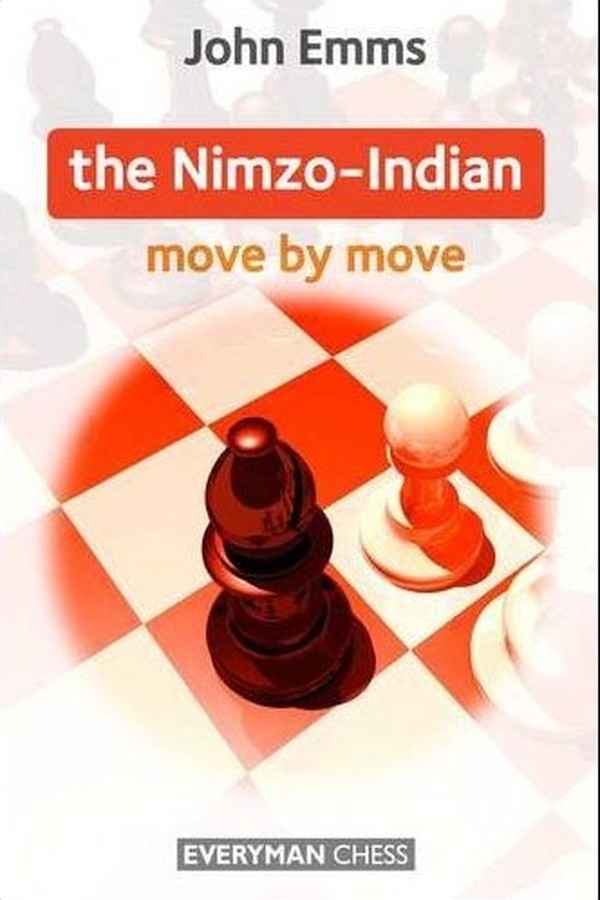| Nivå | B-D |
| Utgivelsesdato | November 2011 |
| Forfatter | |
| Pris | 310 NOK |
The Nimzo-Indian Move by Move
Glede og stas: En skikkelig Nimzoindisk-bok for svartspillere av spesialisten GM John Emms. Formatet er det store i nye serien "move by move" som gjør innholdet ekstra engasjerende og pedagogisk.
Kort fortalt har Emms gjort disse variantvalgene for svart i boka (etter innledende 1 d4 Sf6 2 c4 e6 3 Sc3 Lb4...):
- Sämischvarianten 4 a3 Lxc3+ 5 bxc3 b6
- 4 f3 0-0 5 a3 Lxc3+ 6 bxc3 Se8 7 e4 b6
- 4 e3 0-0 og 5... d5
- 4 Dc2 0-0 5 a3 Lxc3+ 6 Dxc3 d5 og også 4 Dc2 c5 5 dxc5 Lxc5
- Leningradvaianten 4 Lg5 c5
- Kasparovvarianten 4 Sf3 c5 5 g3 Lxc3+ 6 bxc3 Da5
Fra introduksjonen i boka
The Attraction of the Nimzo-Indian
I’ve been playing the Nimzo-Indian for over 30 years, starting as a junior all the way up to grandmaster level. I swapped around with other openings but always remained loyal to the Nimzo.
I’m sure one of the reasons I’m still attracted to the Nimzo-Indian is that I’m always learning something new about it, even after all these years. I discovered quite a few new things during the writing of this book. The Nimzo-Indian is such a flexible opening with so many different possibilities and so many ways to play it. New ideas are always cropping up too, not just novelties in existing lines but whole new variations.Even so, probably the greatest attraction of the Nimzo-Indian is its reliability. The Nimzo-Indian is undoubtedly a sound opening and has no chance of being refuted anytime soon. Yet it also offers players enough imbalances in the position to be able to outplay opponents – the two most typical ones being superior pawn structure versus bishop pair and centre (see Chapter 1-2), and lead in development versus bishop pair (see Chapter 5). I feel it’s these two qualities – soundness and imbalance – which have attracted virtually all the World’s leading players to the Nimzo-Indian at one time or another.
What this book covers
I’ve always thought that one of the most difficult periods of a game is when our opening knowledge runs out, when we are “out of book” – when we have to think for ourselves! This happens in 99% of the games we play, and I’ve tried to address the situation in this book by focussing on the following:
- Typical situations in opening and middlegame positions (and very occasionally thematic endings).
- Typical plans for both sides and how players react to these.
- Typical and thematic tactical opportunities for both sides.
- The principles and guidelines of each variation covered.
- The key questions we should be asking ourselves during study and in game situations.
I’ve also presented the opening theory for each variation covered, and highlighted move-order issues and possible transpositions into other lines in the book.
In general I’ve chosen to cover well known lines, but I’ve also favoured lines which I feel teach us a great deal about the basic principles of the Nimzo-Indian, for example fighting against the doubled c-pawns or exploiting a lead in development when White avoids the doubled pawns.
Being a Nimzo-Indian player for such a long time, I can’t help but have a certain bias to the Black side of this opening, and this book is aimed more at those who play (or want to play) the Nimzo-Indian as Black. I’ve covered a sufficient number of lines so that those playing Black can choose at least one option against every main line White can play. I do feel, though, that the general study of Nimzo-Indian positions, as well as the opening theory, will also be of value to those who prefer playing the White side.
There is a huge number of players whose ideas have contributed immensely to the development of the Nimzo-Indian, and some of these players are featured in this book. Their creative efforts over the board make the task of studying and writing about the Nimzo-Indian much easier, and for this they deserve a huge amount of appreciation. If I had to name just a very few high-profile players, I would mention Anatoly Karpov, Vladimir Kramnik, Michael Adams, Peter Leko, Pavel Eljanov and current World Champion Vishy Anand, all of whose games are well worth following to obtain a better feel for the Nimzo and to check for new ideas. On the White side I should mention Garry Kasparov, Magnus Carlsen, Kramnik (again) and Alexander Morozevich.
| Innbundet? | Nei |
| Type | Bok |
| Førsteutgave år | 2011 |
| Språk | Engelsk |
| Antall sider | 368 |
Produktet er en del av serien Move by Move åpningsbøker
En ny og annerledes serie av åpningsbøker som startet i 2011. Åpningene blir gjennomgått grundig med spørsmål og svar som engasjerer leseren mer direkte i prosesssen gjennom hvert parti. Det er i hovedsak repertoarbøker med instruktive og stor grad ferske partieksempler.
Se også
-

No Fear of 1.d4! Vol. 2 Nimzo-Indian DVD
KjøpTiviakovs drøye 5 1/2 time med Nimzoindisk er det ikke vanskelig å anbefale. Åpningsstoffet hans er velfundert og godt presentert, og Nimzoindisk er en ditto sunn og solid åpning.
- Pris
- 335 34
- Nivå
- B-D
- Av
- Utgivelsesdato
- Januar 2012

